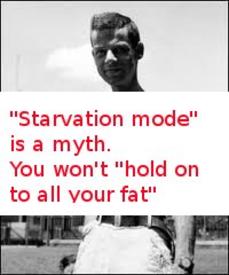Self.com's Nutrition Data - "Fullness Factor"

tomatoey
Posts: 5,446 Member
Just found this - database of foods thought to predict satiety. Thought it was interesting
http://nutritiondata.self.com/topics/fullness-factor
"After studying the results of numerous satiety studies, NutritionData used an advanced multivariate analysis of the existing data to create a new mathematical formula that predicts satiety from the nutrient content of a given food or recipe. This formula yields a value that we call the Fullness Factor (FF):
FF values fall within the range of 0 to 5. Foods with high FF's are more likely to satisfy your hunger with fewer Calories. Foods with low FF's are less likely to satisfy your hunger."
It's macros-based, basically:
FF=MAX(0.5, MIN(5.0, 41.7/CAL^0.7 + 0.05*PR + 6.17E-4*DF^3 - 7.25E-6*TF^3 + 0.617))
where CAL is total Calories per 100g (30 minimum),
PR is grams Protein per 100g (30 maximum),
DF is grams Dietary Fiber per 100g (12 maximum), and
TF is grams total Fat per 100g (50 maximum).
http://nutritiondata.self.com/topics/fullness-factor
"After studying the results of numerous satiety studies, NutritionData used an advanced multivariate analysis of the existing data to create a new mathematical formula that predicts satiety from the nutrient content of a given food or recipe. This formula yields a value that we call the Fullness Factor (FF):
FF values fall within the range of 0 to 5. Foods with high FF's are more likely to satisfy your hunger with fewer Calories. Foods with low FF's are less likely to satisfy your hunger."
It's macros-based, basically:
FF=MAX(0.5, MIN(5.0, 41.7/CAL^0.7 + 0.05*PR + 6.17E-4*DF^3 - 7.25E-6*TF^3 + 0.617))
where CAL is total Calories per 100g (30 minimum),
PR is grams Protein per 100g (30 maximum),
DF is grams Dietary Fiber per 100g (12 maximum), and
TF is grams total Fat per 100g (50 maximum).
-1
Replies
-
Interesting. Any views on how "accurate" it is, or if it matches your experiences.0
-
So I take it carbohydrates (beyond fibre) and alcohol were considered to have a FF of zero beyond caloric value.0
-
How am I flagged for this? Lol0
-
It's neat, especially how you can use it to test a meal, which is far more practical than the glycemic index, which people often misuse for that reason (foods aren't eaten in isolation).
I'd be curious if their predictions match my personal experiences (but probably not enough to test it myself, as that seems like a lot of work!). I do think that if you listen to people talk about their experiences there is quite a bit of variety as to what's satiating, so it might be good on average but of course actual experience governs. For example, I really do find potatoes, when eaten along with a meal, to add to the overall fillingness of the meal to me.
I am also skeptical about the extent to which satiety in a physical sense is really the issue, but this is biased by the fact that it never has been for me. I think I eat in a pretty satiating way, but I find that I feel like I want to eat for non physical reasons (emotions or simply liking the food) and absent those I am generally fine not eating and don't struggle with hunger.0 -
When you hit the flag button it gives you a dropdown to choose which kind of flag you want applied to that particular post. And, it most certainly can be removed (by the same user who set the flag). No, when a post is flagged it's done 100% on purpose.0 -
How am I flagged for this? Lol
Maybe because "Fullness Factor" is trademarked, someone thought this was a corporate placement? It looks like they may be trying to monetize this. OK by me.
I thought it was interesting, actually. It's all heuristics, of course, but there seems to be some sense in it. It's interesting to me to see how these results line up, and where it hits and misses.
It seems to me that this may be especially useful for those who overeat because they don't feel full. It would be less useful for those who are emotional or stress eaters.0 -
Yeah, makes sense.How am I flagged for this? Lol
I thought it was interesting, actually. It's all heuristics, of course, but there seems to be some sense in it. It's interesting to me to see how these results line up, and where it hits and misses.
It seems to me that this may be especially useful for those who overeat because they don't feel full. It would be less useful for those who are emotional or stress eaters.
Agreed.
They apparently have some kind of "try this instead" algorithm that can help with meal planning. I think that's a great idea - figuring it out by trial and error can take a looooong time!lemurcat12 wrote: »It's neat, especially how you can use it to test a meal, which is far more practical than the glycemic index, which people often misuse for that reason (foods aren't eaten in isolation).
I'd be curious if their predictions match my personal experiences (but probably not enough to test it myself, as that seems like a lot of work!). I do think that if you listen to people talk about their experiences there is quite a bit of variety as to what's satiating, so it might be good on average but of course actual experience governs. For example, I really do find potatoes, when eaten along with a meal, to add to the overall fillingness of the meal to me.
I am also skeptical about the extent to which satiety in a physical sense is really the issue, but this is biased by the fact that it never has been for me. I think I eat in a pretty satiating way, but I find that I feel like I want to eat for non physical reasons (emotions or simply liking the food) and absent those I am generally fine not eating and don't struggle with hunger.
Yeah, they do say their calculations are only estimates of satiety, and acknowledge the importance of things being appetizing to any given individual.0 -
Pretty cool. It's like a reverse WW Points calc, sort of. These are traits of foods that WW calc favors as well. But 'worse' foods score higher in their schema.
General Observations
Foods that contain large amounts of fat, sugar, and/or starch have low Fullness Factors, and are much easier to overeat. Foods that contain large amounts of water, dietary fiber, and/or protein have the highest Fullness Factors. These high-FF foods, which include most vegetables, fruits, and lean meats, do a better job of satisfying your hunger.
Read More http://nutritiondata.self.com/topics/fullness-factor#ixzz3PNSsi3Iq
WW calcs: http://en.wikipedia.org/wiki/Weight_Watchers
0
This discussion has been closed.
Categories
- All Categories
- 1.4M Health, Wellness and Goals
- 398.2K Introduce Yourself
- 44.7K Getting Started
- 261K Health and Weight Loss
- 176.4K Food and Nutrition
- 47.7K Recipes
- 233K Fitness and Exercise
- 462 Sleep, Mindfulness and Overall Wellness
- 6.5K Goal: Maintaining Weight
- 8.7K Goal: Gaining Weight and Body Building
- 153.5K Motivation and Support
- 8.4K Challenges
- 1.4K Debate Club
- 96.5K Chit-Chat
- 2.6K Fun and Games
- 4.7K MyFitnessPal Information
- 17 News and Announcements
- 21 MyFitnessPal Academy
- 1.5K Feature Suggestions and Ideas
- 3.2K MyFitnessPal Tech Support Questions






